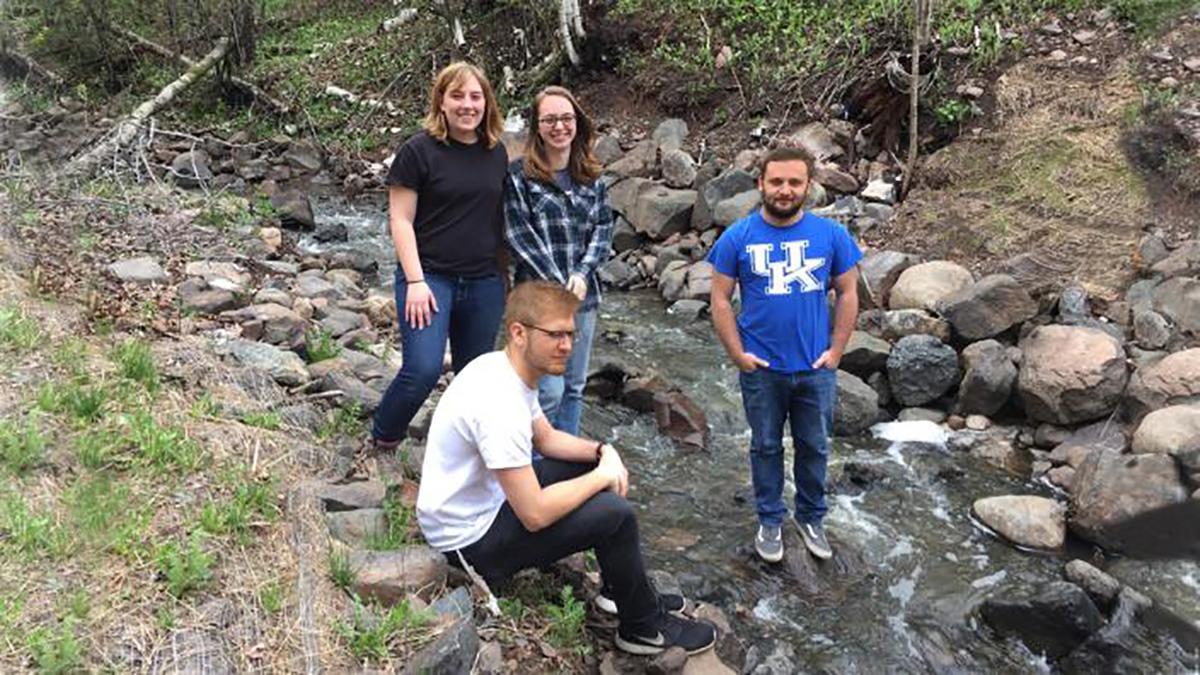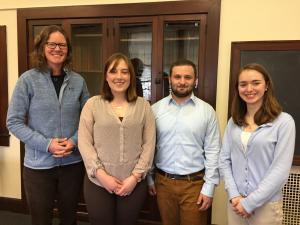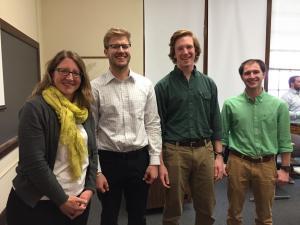Photo above: Kaitlin Reinl, Ellen Cooney, Erik Bye, (seated) and Andrew Camilleri are four of the six students in the UMD Water Resources Management program who worked with private consulting firms through the Large Lakes Observatory initiative.
You can see the lakes and rivers out the airplane window as you fly across the upper Midwest. Sparkling water is surrounded by low hills, high pine trees, rock outcroppings, and sandy shores. The blue, blue, blue of Lake Superior is streaked with white wakes made by huge ships and small boats.
Northland lakes and rivers are important for more than their beauty. They impact the health, economic, and recreation needs of area communities, and dozens of UMD researchers are providing information to keep the water quality stable. In spring 2017, six student researchers, all working on degrees in the UMD water resources science program, gathered data on pressing water issues. UMD's Large Lakes Observatory (LLO) set up partnerships for the students with two environmental consulting firms.
The two teams of graduate students looked at two water quality problems, one in the City of Duluth and the other in Sawyer County, Wisconsin. Neither team took water samples or recorded temperatures. Instead, they gathered and examined data sets to draw fact-based conclusions and make recommendations.
Lac Courte Oreilles (LCO)
“The quality of our water is directly linked to the quality of our lives.” says Andrew Camilleri. Andrew was one of the student researchers who worked on the data collected from Lac Courte Oreilles, a large lake in Sawyer County, Wisconsin. Andrew, Ellen Cooney, and Kaitlin Reinl worked on the LCO project with Dendy D. Lofton, an environmental scientist from the consulting firm LimnoTech. Their task was to investigate the role that nutrient loading (phosphorus in particular) has on fish habitat in LCO.
One issue is keeping the temperature cool enough and oxygen levels high enough to sustain the Cisco and Whitefish populations as well as the population of Muskellunge (Muskies), which grow to be trophy-sized. "Nutrient loading leads to excess algal growth, which can eventually lead to low oxygen conditions," says Andrew. Cool water has other advantages. It holds more oxygen and keeps algal growth to a minimum, making recreation on the lake more enjoyable.
"Our task was to conduct an analysis of the Lac Courte Oreilles coldwater fish habitat," said Ellen. The team analyzed existing data on the causes of algal growth and low dissolved oxygen, "which has a negative impact on boating, fishing, and swimming." Kaitlin says. Recommendations included implementation of a management plan to reduce nutrient input from forest and agriculture runoff, cranberry bogs, wetlands, and shoreline development.
Lake Superior Watershed
The Duluth streams team included Erik Bye, Matt Bambach, and Gage Sachs. Jennifer Olson, a water resource scientist with the consulting firm TetraTech, guided the research. The students crunched data for five creeks: Chester, Kingsbury, Tischer, Amity, Miller; all creeks within the Duluth city limits that flow into Lake Superior.
"There are 16 trout streams in the city," says Erik. "Our data can guide a plan to keep the streams viable for fish." Trout need cool water for survival. When trees are cut down and parking lots or houses are built near the streams, the water temperature rises.
Community Partners
This new educational initiative at UMD's Large Lakes Observatory connects graduate students directly with community partners. Katie Schreiner, assistant professor of chemistry & biochemistry, led the effort. "Our graduate students have the chance to learn directly what kinds of work our consulting partners take on," says Robert Sterner, LLO director. "There are so many benefits to the process. The students benefit from great networking connections. The partners receive additional help with their work and also get to know our UMD students during their training."
The success of this real-world collaboration promises many more partnerships to come.


